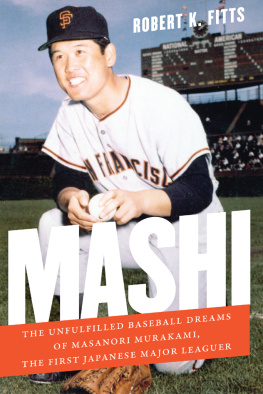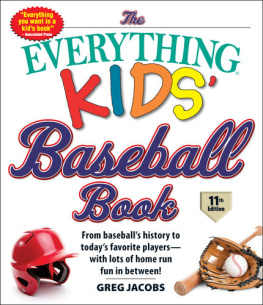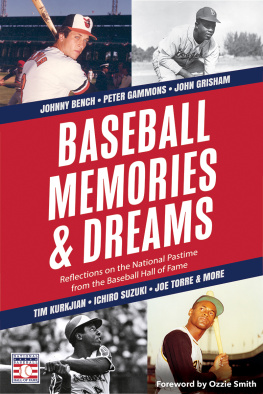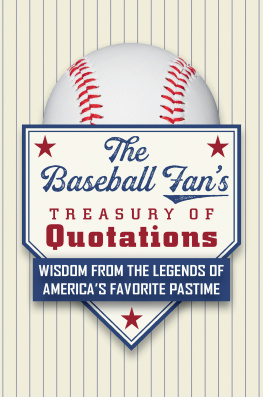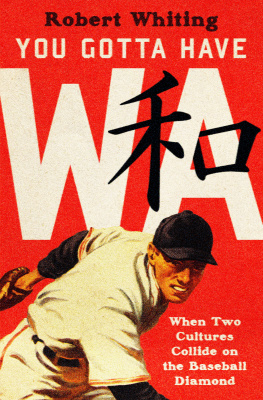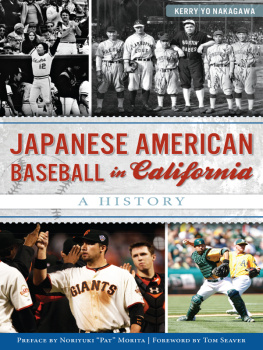
A book rich in detail, Robert K. Fittss Issei Baseball adds a valuable piece to the story of the Japanese people in America and is a noteworthy contribution to the legacy of the Issei and the game they loved.
Samuel O. Regalado, author of Nikkei Baseball: Japanese American Players from Immigration and Internment to the Major Leagues
Rob Fitts is not only an esteemed baseball historian; hes also one of the top writers in the game today. He excels at painting pictures with words and taking the reader on a journey back in time with his prose. Issei Baseball is an enjoyable read for true baseball fans.
Bill Staples Jr., coauthor of Gentle Black Giants: A History of Negro Leaguers in Japan
Long before Ichiro Suzuki and Shohei Ohtani, Japanese Issei were trying to prove they were the best immigrant baseball players in America. During the Jim Crow era of Major League baseball, a handshake and a victory on the field were their just reward. Rob Fitts majestically re-creates the mood of the era and sheds light on a glorious period of this epic American odyssey.
Kerry Yo Nakagawa, author, filmmaker, and historian
Issei Baseball
The Story of the First Japanese American Ballplayers
Robert K. Fitts
University of Nebraska Press | Lincoln
2020 by Robert K. Fitts
Cover designed by University of Nebraska Press; cover image is from the interior.
Author photo courtesy of the author.
Portions of chapters 5 and 6 were previously published as Baseball and the Yellow Peril: Waseda Universitys 1905 American Tour, in Base Ball 10: New Research on the Early Game, ed. Don Jensen (Jefferson NC : McFarland, 2018), 14159. Used with permission.
All rights reserved.
Library of Congress Cataloging-in-Publication Data
Names: Fitts, Robert K., 1965 author.
Title: Issei baseball: the story of the first Japanese American ballplayers / Robert K. Fitts.
Description: Lincoln: University of Nebraska Press, 2020. | Includes bibliographical references and index.
Identifiers: LCCN 2019027695
ISBN 9781496213488 (Cloth)
ISBN 9781496220875 (ePub)
ISBN 9781496220899 ( PDF )
ISBN 9781496220882 (Mobi)
Subjects: LCSH : Baseball playersJapanBiography. | Baseball teamsUnited StatesHistory20th century. | BaseballJapanHistory. | JapanEmigration and immigration. | United StatesEmigration and immigration. | Japanese AmericansEvacuation and relocation, 19421945. | World War, 19391945Japanese Americans. | Green, Guy W.
Classification: LCC GV 863.77. A 1 F 57 2020 | DDC 796.3570952dc23
LC record available at https://lccn.loc.gov/2019027695
The publisher does not have any control over and does not assume any responsibility for author or third-party websites or their content.
In memory of dArtagnan.
We miss you.
The early history of Japanese immigrants in the United States, far from being a success story, is, above all, a history of a racial minority struggling to survive in a hostile land.
Yuji Ichioka, The Issei
There has been no greater agency in bringing our different races together than our national game, baseball. Baseball is our real melting pot.
Fred Lieb, Baseball: The Nations Melting Pot, Baseball Magazine
Contents
In order of appearance:
Atsuyoshi Harrry Saisho (At-sue-yoh-shee Sigh-show)
Shichiji Kikuchi (Shee-chee-gee Kee-koo-chee)
Ken Kitsuse (Ken Keet-sue-say)
Tozan Masko (Toe-zan Mas-koe)
Hanzaburo Harase (Han-zah-boo-roe Hah-rah-say)
Kotan Saito (Ko-tan Sigh-toe)
Takejiro Ito (Ta-key-ji-roe Ee-toe)
Isoo Abe (Ee-Sow Ah-bay)
Sukekatsu Izumitani (Sue-ke-kat-sue Ee-zoo-me-tah-nee)
Shin Hashido (Sheen Hah-shee-doe)
Atsushi Kono (Aht-sue-shee Koh-no)
Tetsusaburo Tom Uyeda (Tet-sue-sa-boo-roh Oo-yay-dah)
Junjiro Uyeda (June-jee-roh Oo-yay-dah)
Takatomo Bob Uyeda (Tah-kah-toe-moe Oo-yay-dah)
Toyo Fujita (Toe-yo Foo-gee-tah)
Umekichi Kitty Kawashima (Oo-may-kee-chee Kah-wah-shee-mah)
Shoichi Motohashi (Show-ee-chee Moe-toe-hah-shee)
Naito (Nigh-toe)
Kiichi Onitei Suzuki (Key-ee-chee Oh-knee-tay Sue-zoo-key)
Isamu Maeda (Ee-sah-moo Mah-ay-dah)
Minori Sohara (Mee-no-ree So-hah-rah)
Riichiro Shiraishi (Ree-ee-chee-roh Shee-rah-ee-shee)
Takizo Takasugi (Tah-kee-zoe Tah-kah-sue-ghi)
Goro Mikami (Go-roe Mee-kah-mee)
Kazuma Sugase (Kah-zoo-mah Sue-gah-say)
Tokutaro Tachiyama (Toe-koo-tah-roh Tah-chee-yah-mah)
Takaji Kubo (Tah-kah-gee Koo-boh)
Kesaichi Arthur Shiomichi (Kay-sigh-chee Shee-oh-mee-chee)
White-haired and frail, the old men lounged around a large table at Nikko-ro in Los Angeless Little Tokyo, reminiscing about summer days long past. Chopsticks lay discarded beside empty plates dribbled with soy sauce. The platters were empty, for life had been hard, and they had learned long ago not to waste food. But the beer glasses and tea cups remained full as they sipped and remembered.
Ken Kitsuse took out some photographsfading images of young men in baseball uniforms taken nearly fifty years earlier. His lifetime friends Atsuyoshi Harry Saisho and Kiichi Suzuki leaned over to get a better look at their old teammatesso many of them gone now: the brash promoter Tozan Masko; the friendly Tetsusaburo Tetsu/Tom Uyeda; Japans greatest player Shin Hashido. The young Issei (Japanese immigrants) had played together on many teams, becoming the first Japanese professional ballplayers when they barnstormed across the American Midwest in 1906. They had played in front of thousands of people, been featured in hundreds of newspapers, and traveled throughout the country. Kitsuse had been called the greatest Japanese shortstop in the world bar none. But the exploits of their youth were forgotten by nearly all outside of the room.
Baseball was a vital part of Japanese American culture. During the 1920s and 30s, thousands of Nisei (Japanese born outside of Japan) children and adults played in organized leagues. The games became a meeting place for the communitya place to socialize, discuss local concerns, talk business, swap gossip. The top teams challenged white and African American nines, entered regional tournaments, and occasionally traveled to Japan. Regional stars became local celebrities and heroes to the Japanese American youth. A handful of players even played professionally in the minor leagues, becoming beacons of ethnic pride. This passion for the game became crucial during World War II, when one hundred thousand Japanese Americans were incarcerated in internment camps. Baseball Saved Us, Ken Mochizuki titled his award-winning book on the game during internment. The sport provided an outlet for the frustrations of a people unjustly removed from their homes and helped build morale and a sense of normalcy during this difficult time.
This golden era of Japanese American baseball and the games importance during internment are well documented through the stellar work of many scholars.
This story will focus on the pioneers of Japanese American baseball: Harry Saisho, Ken Kitsuse, Tozan Masko, Tom Uyeda, and Kiichi Suzuki. They were the sons and grandsons of samuraitheir fathers born just before Commodore Matthew Perrys arrival in 1853 led to the collapse of the feudal system and the rise of Modern Japan. To prepare their children for Japans new place in the world, their fathers sent them to private schools to study Western ideas and knowledge. There they fell in love with the new American game of baseball.
Next page

